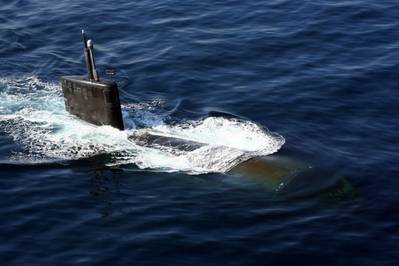Sequestration Prevents Repair of USS Miami
By Rear Adm. Richard Breckenridge, Director, Undersea Warfare
USS Miami was set ablaze by an arsonist in May 2012. The Navy recently completed a comprehensive assessment of the extensive fire damage, finding that the submarine is fully repairable from a technical perspective; however, inspections have revealed a greater scope of work than originally envisioned.
Under the financial constraints of sequestration, the Navy said it cannot afford to undertake the repairs. Sequestration effects this past year (work force limitations) coupled with the increased scope of work have combined to raise the estimated cost of repairs from $450 million to $700 million. Given the fiscal challenge facing the country and the strain that such an investment would make on the maintenance for the remainder of the fleet, the responsible decision, the Navy said, is to inactivate Miami.
A Rock and a Hard Place: A Colossal Work Effort in a Time of Fiscal Austerity
The demand signal for attack submarines is as strong as ever. Around the world, the Navy’s combatant commanders recognize the unique value provided by undersea forces, and request them in nearly double the quantity that the Navy is able to provide. So the Navy said it wants to do everything possible to maintain a robust SSN force. This impetus was the basis of its original intent to return Miami to service.
So what’s changed? USN recognized from the start that repairs to Miami presented a significant technical challenge. The type of damage was unlike anything we’d seen in recent memory, meaning the effort contained plenty of unknowns. Moreover, the planners had to recreate drawings for a ship built with different construction methods from those used today. Above and beyond the nature of the work, the pure size of the job is staggering: the anticipated scope of work is four times greater than any previous submarine repair due to damage and 50 percent larger even than that of an Engineered Overhaul, the largest and most demanding maintenance availability performed on a submarine. In times of prosperity with more flexible defense spending, sufficient resources would be available for our industrial base partners to rise and tackle this formidable challenge. However, sequestration pressures remove the needed foundation of stability to support an endeavor of this magnitude.
Sequestration Effects are Real and Hampered Navy Progress This Past Year
The initial damage assessment and repair estimate came around the same time as the commencement of sequestration spending cuts. Portsmouth Naval Shipyard began Fiscal Year 2013 with a workforce tasked to full capacity; these cuts required the shipyard to implement a hiring freeze and to sharply restrict overtime, limiting their available workforce and requiring the damage assessment and planning to be shifted to Electric Boat. According to the navy, shifting the work to the world’s finest private shipbuilder is not without a cost impact.
Further, damage inspections revealed that the high temperature environment and corrosive atmosphere present during the prolonged fire caused a phenomenon known as Environmentally Assisted Cracking to occur in steel piping and fasteners used in the air, hydraulic and cooling water systems. Due to the nature of the cracking, a significant number of components in the torpedo room and auxiliary machine room would require replacement. Although the Navy was aware of the possibility of Environmentally Assisted Cracking, it was not until May 2013 that the full scope and cost was understood.
Unknown Unknowns: Future Risk Necessitates a Reset of Contingency Funds
Since the initial cost estimates were made, the Navy analyzed other recent major submarine damage repair efforts to gain insight into the accuracy of initial rough order of magnitude repair cost estimates. Data gathered from repairs to USS Hartford and USS Montpelier indicate that the final cost typically falls between 140 to 150 percent of the initial repair rough order of magnitude estimate due to unforeseen repair issues/complications. Therefore it was appropriate to apply this cost planning insight to Miami and establish responsible contingency reserves.
In addition to scope growth, this contingency funding would cover other cost growth, whether unanticipated or expected but unable to be accurately priced. For example, a known impact that cannot be accurately priced is the anticipated FY 2014 sequestration impact at Portsmouth Naval Shipyard, which will likely diminish the shipyard’s ability to provide Lead Yard Services (cranes, ventilation, electricity, service air, etc.) for Electric Boat’s execution of production work.
The Responsible Choice, and Yet a Tough One at That
The combination of these effects — sequestration effects in 2013 and the expanded scope of work — resulted in two adverse consequences: the bulk of the repair effort was pushed from FY 2013 to FY 2014, and the cost estimate increased from $450 million to $700 million.
Sequestration could levy a devastating burden on FY 2014 maintenance spending, causing the potential cancellation of up to 60 percent of scheduled availabilities. The shift in Miami repairs and the increased cost estimate means that without $390 million in additional resources in FY 2014, funding the repairs would require cancellation of dozens of remaining availabilities on surface ships and submarines. The Navy and the nation cannot afford to weaken other fleet readiness in the way that would be required to afford repairs to Miami.
The U.S. Navy is a capital-intensive force that requires funding to operate forward, and sequestration limits its ability to responsibly cashflow maintenance, planning and operations to maintain the what it sees as a necessary level of readiness. The decision to inactivate Miami is a difficult one, taken after hard analysis and not made lightly, the Navy said. It will lose the five deployments that Miami would have provided over the remaining ten years of her planned service life, but in exchange for avoiding the cost of repairs, we will open up funds to support other vital fleet maintenance efforts, improving the wholeness and readiness of the force. Inactivation is the right choice for the Navy and the nation during a very unique time period in our nation’s history.












